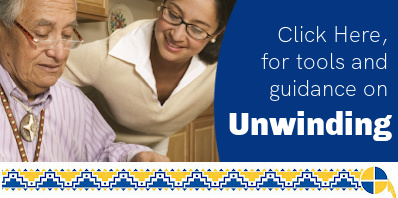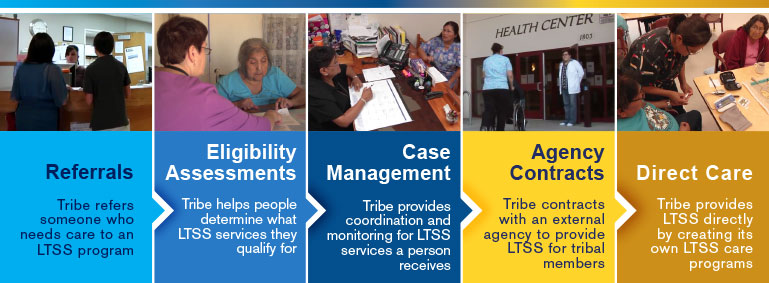
Tribal Involvement

After gathering information on LTSS needs and the LTSS currently available in your community, you may have questions about how your tribe will be involved in planning and developing the program. This page lists the different ways in which tribes can support LTSS efforts. Since housing availability often determines whether a person can stay in the community, housing resources are also provided.
Starting a new program? Your tribe may be interested in interim activities—what to do while you plan and develop your LTSS program.
The Program Examples page offers stories of how individual tribes are becoming involved in LTSS.
How Tribes Can Be Involved
Tribes may offer a variety of services to meet LTSS needs in their communities. Those services can range from simpler services that cost less, such as providing referrals for patients to receive LTSS care elsewhere, to costly services that require a great deal of tribal commitment, such as providing direct care services.
The graphic below describes a range of ways tribes can be involved, from the least tribal involvement required to the most. Each type of involvement is described in more detail in the sections that follow.

Referrals
Your tribe can refer people who need LTSS to your program or other available services in your community. The tribe might also refer members to outside LTSS programs or government offices for services that your community or program does not currently offer.
Eligibility Assessments
An eligibility assessment means that the tribe determines what types of available LTSS options an individual is eligible for. An assessment also determines whether the person qualifies for Medicaid. Assessments are important for educating individual community members about what services are available to them and how they can finance those services.
Case Management
When a tribal member contracts with an LTSS agency or caregiver, the tribe can manage the care of that person. By providing case management services, tribes help their members navigate LTSS and health care systems. In addition, tribes can act as patient advocates to ensure their members receive culturally appropriate care.
If your tribe does not wish to handle case management, inquiries can be referred out to other entities.
Resources
To learn more about case management, check out these resources:
- Read Case Management, a Tribal Perspective (PDF) (1,020 KB, webinar slides) to learn how tribes are getting involved in case management for elders.
- Learn about Home and Community-Based Services for Native Elders: Pathway to CHR Targeted Case Management at Standing Rock Sioux Tribe (PDF) (2.63 MB, webinar slides).
Agency Contracts
If a tribe does not have the population or other resources needed to operate an LTSS program itself, the best alternative may be to find another agency who can serve tribal members and set up a contract with that agency. Contracting may also be a good option if your tribe is located close to comprehensive LTSS programs that already exist, and that are willing to respect AI/AN culture in service delivery.
To learn more about how tribes can successfully contract with other entities, watch Tribal Partnerships: How the Arizona Health Care System Addresses the Long-Term Care Needs of Tribal Medicaid Members.
Direct Care
To provide direct care, a tribe must be accredited to operate as a home care agency or facility-based LTSS program. Once the program is accredited, a tribe can directly provide LTSS to its members. If you are unsure of how to start looking into the accreditation process, these considerations can help you get started.
Resources
For more information on tribal involvement in direct care, see these resources:
- Watch this webinar recording on the Menominee Indian Tribe of Wisconsin's Model of Long Term Care (webinar recording, 48 min), which explains how Menominee administers a state Medicaid waiver program.
- View the Tohono O'odham Nursing Care Authority presentation (PDF) (4.62 MB, webinar slides), which describes the development of a tribally based skilled nursing facility and hospice, certified by Medicare, by the Tohono O'odham Nation.
Elder Safety and Abuse Prevention
- Convene an elder task force to meet, identify potential problems or risks, and advise the community on elder abuse issues
- Develop an elder safety code to protect older community members from physical, mental, emotional, or other kinds of abuse
- Implement elder abuse best practices to address risk factors for elder abuse
Resources
Learn more about elder abuse prevention efforts used by different tribes through these resources:
- Read about best practices for preventing elder abuse.
- See information on the forms and causes of elder abuse, strategies for abuse prevention, and special considerations for AI/AN populations.
- Read about elder justice in Indian Country (PDF)(180 KB, webinar transcript).
- Look at these fact sheets to learn how five different tribal programs work to prevent elder abuse.
Housing Considerations
Housing for older adults is an important need in many communities. The availability of housing resources often determines whether a person can stay in his or her own home instead of receiving care in a separate facility outside of the community.
Think about what you learned from your needs assessment. Is housing a priority need in your community? How does this need tie in with the other needs you found?
Although housing is a common LTSS need, sources that fund health-related LTSS needs do not usually cover housing services. For example, home- and community-based services (HCBS) do not include funding for housing or home modifications.
Explore the Housing Capacity Building Initiative for Community Living Resource Center, which offers information and resources that can help you find funding solutions for housing needs.
Interim Activities for Tribes
Tribes can engage in activities that allow them to provide some LTSS now, before a formal LTSS program is set up. These activities are designed to help tribes become involved in LTSS in small steps.
- Consider additional supportive services. Some non-medical services for older adults, such as transportation or help with personal care tasks like bathing, can be provided as part of HCBS. Services your tribe already provides may be eligible for reimbursement. For example, Medicaid transportation reimbursements are available in every state.
See LTSS in Indian Country-Part 2: Home- and Community-Based Services (PDF) (406 KB, webinar slides) for information on providing additional HCBS services like nutrition, grooming, and laundry assistance.
Read about the Gila River Indian Community: The Caring House-Development of an Adult Day Program (PDF) (4.37 MB, webinar slides) that focuses on non-medical services for tribal members.
- Get involved with existing programs. This start-up period is a good time to start building informal relationships. Partner with existing programs to learn about providing LTSS in your community, and connect interested elders with already existing services. Working with a different program can let a tribe see how services, assessments, and case management are conducted, as a way to learn what services work best for people.
- Help tribal members with Medicaid applications and paperwork. By helping people qualify for Medicaid, tribes can become familiar with the process and eligibility qualifications, and learn how tribal supports (like per capita payments) fit into this picture. Helping people to navigate this often complicated process can increase Medicaid enrollment, which would increase income for your program.
- Look for partner programs. Are there facilities or programs in your area that you could share staff, resources, or equipment with? Another valuable resource to share is training or mentoring. Interested people can "shadow" health care professionals in a partner program to observe how things are done.
See Leveraging Resources for Long-Term Services and Supports (webinar recording, 48 min) for ideas on how to use resources like facilities, personnel and equipment to maximize services
- Recruit and organize for caregivers now. If tribal members or family members who plan to serve as caregivers begin training with non-tribal programs, they can be ready to work in the tribal program as soon as it is established, and elders will have Native caregivers.
- It is also important to know what your state's requirements are for caregivers, such as state rules about background checks, so that you can start on any steps you may need to take to hire and train caregivers. These requirements vary from state to state. The State Resources Map is a good starting point for finding this information. Once you get to the map, click on your state, and follow links related to this issue to find state-specific information.
- Begin sharing information and educating the community. Because many other people are involved in the planning and operations of your program, you will need to help your tribal leaders and community understand and support your efforts and the benefits your program will provide. Check the Tribal Leaders section for guidance on how to do this.
